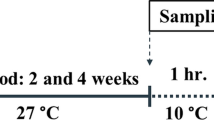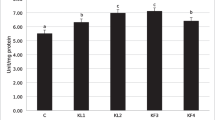Abstract
The present study evaluated effects of ultrafine powder of the green macroalgae Enteromopha prolifera as dietary supplement on growth performance, digestive enzyme activities and serum nonspecific immune responses of the red tilapia ( Oreochromis mossambicus × Oreochromis niloticus ). The red tilapia were fed five diets supplemented with different levels of E. prolifera ultrafine powder as well as a control diet containing no E. prolifera for seven weeks (Diets 0–6 contained 0 (control), 10, 20, 30, 40 and 50 g/kg of E. prolifera ultrafine powder, respectively). The results showed that diets supplemented with E. prolifera ultrafine powder generally improved growth, immunity and digestive enzyme activities of the red tilapia. In particular, the fish fed the diet incorporated 50 g/kg (5%) E. prolifera ultrafine powder (Diet 5) achieved the highest percentage weight gain, specific growth rate and the condition factor (increased by 15.4%, 8.0% and 5.7%, respectively when compared to the control). Feeding the diet also led to significantly increases ( P <0.05) in serum nonspecific immune responses, including total superoxide dismutase, acid phosphatase, alkaline phosphatase, lysozyme activities and serum total protein (increased by 19.4%, 48.1%, 29.5%, 30.3% and 8.7%, respectively) as well as digestive enzyme activities of erepsin, gastric amylase, gastric lipase, pepsin, intestinal amylase and gastric lipase (increased by 15.7%, 33.3%, 16.3%, 21.3%, 52.3% and 28.2%, respectively) than those of the control. Based on these results, it is recommended that the inclusion level of E. prolifera ultrafine powder in the diet of the red tilapia should be 50 g/kg (or 5%).
Similar content being viewed by others
References
Aguilera–Morales M, Casas–Valdez M, Carrillo–Domı́Nguez S, González–Acosta B, Pérez–Gil F. 2005. Chemical composition and microbiological assays of marine algae Enteromorpha spp. as a potential food source. J. Food C ompos. Anal., 18(1): 79–88.
Asino H, Ai Q H, Mai K S. 2011. Evaluation of Enteromorpha prolifera as a feed component in large yellow croaker ( Pseudosciaena crocea, Richardson, 1846) diets. Aquac. Res., 42(4): 525–533.
Booth M A, Allan G L, Smullen R P. 2013. Digestibility of common feed ingredients by juvenile mulloway Argyrosomus japonicus. Aquaculture, 414–415: 140–148.
Bricknell I, Dalmo R A. 2005. The use of immunostimulants in fish larval aquaculture. Fish & Shellfish Immun ology, 19(5): 457–472.
Buddington R K. 1987. Does the natural diet influence the intestine's ability to regulate glucose absorption? Journal of Comp arative Physiol ogy B, 157(5): 677–688.
Castro R, Zarra I, Lamas J. 2004. Water–soluble seaweed extracts modulate the respiratory burst activity of turbot phagocytes. Aquaculture, 229(1–4): 67–68.
Chapman V J, Chapman D J. 1980. Seaweeds and Their Uses. Chapman and Hall, London. p.98–148.
Chiu A, Li L P, Guo S J, Bai J F, Fedor C, Naylor R L. 2013. Feed and fishmeal use in the production of carp and tilapia in China. Aquaculture, 414–415: 127–134.
Cho K, Vaught T G, Ji H, Gu D M, Papasakelariou–Yared C, Horstmann N, Jennings J M, Lee M, Sevilla L M, Kloc M, Reynolds A B, Watt F M, Brennan R G, Kowalczyk A P, McCrea P D. 2010. Xenopus Kazrin interacts with ARVCF–catenin, spectrin and p190B RhoGAP, and modulates RhoA activity and epithelial integrity. J. Cell Sci., 123(23): 4 128–4 144.
Dalmo R A, Ingebrigtsen K, Bøgwald J. 1997. Non–specific defence mechanisms in fish, with particular reference to the reticuloendothelial system(RES). J. Fish Dis., 20(4): 241–273.
Gatlin III D M, Bai S C, Erickson M C. 1992. Effects of dietary vitamin E and synthetic antioxidants on composition and storage quality of channel catfish, Ictalurus punctatus. Aquaculture, 106(3–4): 323–332.
Glencross B. 2009. Ingredient evaluation in aquaculture: digestibility, utilisation and other key nutritional parameters. In: Burnell G, Allan G eds. New Technologies in Aquaculture: Improving Production Efficiency, Quality and Environmental Management. Woodhead Publishing Limited and CRC Press LCC, Cambridge, UK. p.387–416.
Harnedy P A, FitzGerald R J. 2011. Bioactive proteins, peptides, and amino acids from macroalgae. J. Phycol., 47(2): 218–232.
Hiraoka M, Dan A, Shimada S, Hagihira M, Migita M, Ohno M. 2003. Different life histories of Enteromorpha prolifera(Ulvales, Chlorophyta) from four rivers on Shikoku Island, Japan. Phycologia, 42(3): 275–284.
Jian J C, Wu Z H. 2003. Effects of traditional Chinese medicine on nonspecific immunity and disease resistance of large yellow croaker, Pseudosciaena crocea(Richardson). Aquaculture, 218(1–4): 1–9.
Kim M J, Oh H J, Park J E, Kim G A, Hong S G, Jang G, Kwon M S, Koo B C, Kim T, Kang S K, Ra J C, Ko C, Lee B C. 2011. Generation of transgenic dogs that conditionally express green fluorescent protein. Genesis, 49(6): 472–478.
Kolkovski S. 2001. Digestive enzymes in fish larvae and juveniles–implications and applications to formulated diets. Aquaculture, 200(1–2): 181–201.
Koren G, Bologa M, Pastuszak A. 1994. The way women perceive teratogenic risk: the decision to terminate pregnancy. In: Koren G ed. Maternal–Fetal Toxicology. 2 nd edn. Marcel Dekker, Inc., New York. p.727–736.
Magnadóttir B. 2006. Innate immunity of fish(overview). Fish & Shellfish Immun ology, 20(2): 137–151.
Michalak I, Chojnacka K. 2009. Edible macroalga Ulva prolifera as microelemental feed supplement for livestock: the fundamental assumptions of the production method. World Journal of Microbiology and Biotechnology, 25(6): 997–1 005.
Oohusa T. 1993. Recent trends in Nori products and markets in Asia. J. Appl. Phycol., 5(2): 155–159.
Rawling M D, Merrifield D L, Davies S J. 2009. Preliminary assessment of dietary supplementation of Sangrovit® on red tilapia( Ore o chromis niloticus ) growth performance and health. Aquaculture, 294(1–2): 118–122.
Richter H, Francis G, Becker K. 2002. A reassessment of the maintenance ration of red tilapia. Aquacult ure Int ernational, 10(1): 1–9.
Romana–Eguia M R R, Eguia R V. 1999. Growth of five Asian red tilapia strains in saline environments. Aquaculture, 173(1–4): 161–170.
Saurabh S, Sahoo P K. 2008. Lysozyme: an important defence molecule of fish innate immune system. Aquac. Res., 39(3): 223–239.
Stone D A J, Allan G L, Parkinson S, Frances J. 2003. Replacement of fishmeal in diets for Australian silver perch Bidyanus bidyanus(Mitchell). II. Effects of cooking on digestibility of a practical diet containing different starch products. Aquac. Res., 34(3): 195–204.
Sun Y Z, Yang H L, Ma R L, Lin W Y. 2010. Probiotic applications of two dominant gut Bacillus strainswith antagonistic activity improved the growth performance and immune responses of grouper Epinephelus coioides. Fish Shellfish Immun., 29: 803–809.
Tkacova K, Stevulova N. 1998. Selected problems of the dispersity analysis of milled ultrafine powders. Freiberger Forschungshefte A, A841: 14–25.
Van Muiswinkel W B, Nakao M. 2014. A short history of research on immunity to infectious diseases in fish. Dev. Comp. Immunol., 43(2): 130–150.
Wassef E A, El–Sayed A F M, Sakr E M. 2013. Pterocladia (Rhodophyta) and Ulva(Chlorophyta) as feed supplements for European seabass, Dicentrarchus labrax L., fry. Journal of Applied Phycology, 25(5): 1 369–1 376.
Wassef E A, Saleh N E, El–Abd El–Hady H A. 2009. Vegetable oil blend as alternative lipid resources in diets for gilthead seabream, Sparus aurata. Aquacult ure Internat ional, 17(5): 421–435.
Wei J T, Wang S X, Liu G, Dong P, Liu Y F, Liu Y, Di D L. 2014. Polysaccharides from Enteromorpha prolifera enhance the immunity of normal mice. International Journal of Biological Macromolecules, 64: 1–5.
Wei S S, Wiens D A, Zha Y, Plank T, Webb S C, Blackman D K, Dunn R A, Conder J A. 2015. Seismic evidence of effects of water on melt transport in the Lau back–arc mantle. Nature, 518(7539): 395–398.
Xu D L, Huang X C, Ou C R, Xue C H, Yang W G, Wang H H. 2005. In vitro study on polysaccharides in Enteromorpha with non–specific immunity. Food Science, 26(10): 232–235.(in Chinese with English abstract)
Yang H, Li Z B, Chen Q, Li W J, Sun Y Z, Lu J. 2016. Effect of fermented Enteromopha prolifera on the growth performance, digestive enzyme activities and serum nonspecific immunity of red tilapia( Oreochromis mossambicus Oreochromis niloticus ). Aquac. Res., 47(12): 4 024–4 031.
Yao D R. 2011. Enteromorpha. Marine Press, Beijing, China. p.1–20, 106–147.(in Chinese)
Yousif E. 2012. Synthesis, spectroscopic studies and fungicidal activity of some diorganotin(IV) with 2–[(phenylcarbonyl) amino] propanoato. Journal of King Saud University–Science, 24(2): 167–170.
Yousif N J, Lifchez S D, Nguyen H H. 2004. Transverse rectus sheath plication in abdominoplasty. Plast ic and Reconstructive Surgery, 114(3): 778–784.
Zeng C K, Zhang D R, Zhang J F. 1962. Chinese Economic Seaweed. Beijing Science and Technology Press, Beijing, China. p.43–50.(in Chinese)
Zhou G C, Bao Z Q, Dixon J E. 1995. Components of a new human protein kinase signal transduction pathway. J. Biol. Chem., 270(21): 12 665–12 669.
Acknowledgement
We thank Dr. ZENG Chaoshu of College of Marine & Environmental Sciences, James Cook University, Australia for editing this manuscript.
Author information
Authors and Affiliations
Corresponding author
Additional information
Supported by the Natural Science Foundation of Fujian Province (No. 2017J01638), the Science and Technology Project Grant of Xiamen City, China (No. 3502Z20113029), and the Key Project of Technology Grant of Fujian Province (No. 2012N0018)
Rights and permissions
About this article
Cite this article
Li, Z., Yang, H., Shangguan, J. et al. Growth performance, digestive enzyme activities and serum nonspecific immunity of the red tilapia ( Oreochromis mossambicus × Oreochromis niloticus ) fed diets supplemented with ultrafine powder of Enteromopha prolifera. J. Ocean. Limnol. 36, 1843–1850 (2018). https://doi.org/10.1007/s00343-018-7142-5
Received:
Accepted:
Published:
Issue Date:
DOI: https://doi.org/10.1007/s00343-018-7142-5




